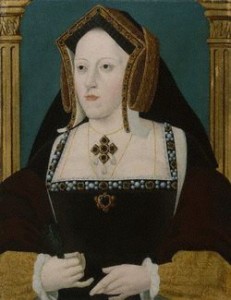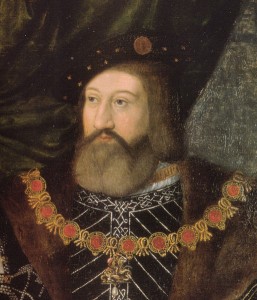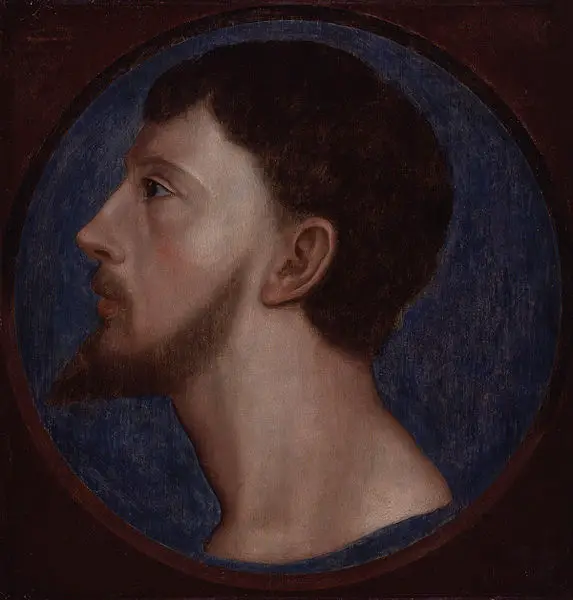 On 9th April 1533, the Dukes of Norfolk and Suffolk accompanied by a delegation from King Henry VIII met with Queen Katherine of Aragon at her residence at Ampthill where she had been moved to in February. When they arrived they informed Katherine that she was no longer Queen of England, but from that day forward she had to style herself as the Dowager Princess of Wales. Katherine took the news with grace but refused neither to use the new title nor to believe that Henry’s marriage to Anne Boleyn was valid.
On 9th April 1533, the Dukes of Norfolk and Suffolk accompanied by a delegation from King Henry VIII met with Queen Katherine of Aragon at her residence at Ampthill where she had been moved to in February. When they arrived they informed Katherine that she was no longer Queen of England, but from that day forward she had to style herself as the Dowager Princess of Wales. Katherine took the news with grace but refused neither to use the new title nor to believe that Henry’s marriage to Anne Boleyn was valid.
Henry VIII had married Anne Boleyn in a secret ceremony on 25th of January 1533 in the high chamber over the Holbein Gate at York Palace. The King had sought to have his marriage to Katherine of Aragon annulled due to the belief that he had broken God’s law by marrying his brother’s widow. The King sought support from the Pope but at the time events in Europe were against Henry and the Pope refused to grant the King’s wishes. Frustrated that he was not getting anywhere Henry VIII took matters into his own hands. He had himself declared Supreme Head of the Church of England in so far as the law allowed. He also had Parliament pass an act entitled the ‘Act of Restraint of Appeals’ which stressed the sovereign authority of England which was governed by the King. The act also challenged the Pope’s authority over the English Church and forbade any spiritual matters to be appealed by the Pope. In essence, Henry VIII was the head of the English Church and all its laws and Katherine of Aragon was not allowed to have the validity of her marriage decided by the Pope. Now the person who had the final say on her marriage was Henry.
On Saturday 12th April 1533, Anne Boleyn was presented at court as Queen. She attended mass dressed in robes of estate and wearing beautiful jewels. Following this, on 28th May Archbishop Cranmer declared that Henry VIII’s marriage to Katherine of Aragon was invalid and that his marriage to Anne was lawful.
On 3rd July, Katherine was given the papers stating that her marriage to Henry VIII had been annulled and that the King was lawfully married to Anne Boleyn. As the King could not have two wives it was essential that Katherine now style herself as Princess Dowager. This time, Katherine was outraged and declared that she did not recognise any judgement made except that of the Pope.
In December, the Duke of Suffolk and a delegation were once more sent to try and convince Katherine that she was no longer to style herself Queen of England, and in addition, she must be moved from her present lodgings to Somersham. When the Duke of Suffolk informed Katherine of her upcoming move Katherine stated that she would rather be hewn into pieces than be called Dowager Princess and that she absolutely refused to go to Somersham, then she slammed the door in the Duke’s face! The Duke was left standing outside of the door trying to implore Katherine to see reason and to accept her new position.
The Duke of Suffolk then went on to question Katherine’s servants and they too refused to refer to her as Dowager Princess and insisted that Katherine was Queen. Five days passed in which time the Duke’s men removed the furniture and hangings from the house as well as dismissing most of Katherine’s servants. During this time, he continued to try and persuade Katherine to leave but she insisted that the only way she would go was if he broke down the door; an action the Duke clearly would not undertake for fear of the ramifications. The Duke of Suffolk was at a complete loss and wrote to Henry explaining the situation and even going so far as to say that he thought the only way they could transport Katherine was if they bound her with ropes! He requested the King’s guidance as to what he should do and had to wait until 31st of December when he received instructions from the King that he should leave Katherine where she was and return to court.Despite being ordered to no longer refer to herself as Queen and to accept the title as Dowager Princess of Wales, Katherine utterly refused to accept that there was any other Queen in England beside herself. Until her death on 7th January 1536, Katherine continued to style herself as Queen, despite the fact that Anne Boleyn had been declared the King’s lawful wife and had been crowned on 1st June 1533. In fact shortly before her death, Katherine wrote one last letter to the King, confessing her love to Henry and imploring him to be good to their daughter Mary. In this last letter Katherine showed her belief that she was still Queen of England by signing it, ‘Katherine the Queen’.
My most dear lord, king and husband,
The hour of my death now drawing on, the tender love I owe you forceth me, my case being such, to commend myself to you, and to put you in remembrance with a few words of the health and safeguard of your soul which you ought to prefer before all worldly matters, and before the care and pampering of your body, for the which you have cast me into many calamities and yourself into many troubles. For my part, I pardon you everything, and I wish to devoutly pray God that He will pardon you also. For the rest, I commend unto you our daughter Mary, beseeching you to be a good father unto her, as I have heretofore desired. I entreat you also, on behalf of my maids, to give them marriage portions, which is not much, they being but three. For all my other servants I solicit the wages due them, and a year more, lest they be unprovided for. Lastly, I make this vow, that mine eyes desire you above all things.
Katharine the Quene.
On 29th January 1536, Catherine of Aragon was buried at Peterborough Abbey (now known as Peterborough Cathedral), despite her wish to be buried in a Chapel belonging to The Observant Friars (which unfortunately no longer existed due to the Dissolution of the Monasteries). Katherine was buried as Dowager Princess of Wales, despite her belief that she was still Queen of England. However, today Katherine’s grave is marked “Katherine, Queen of England”, perhaps a fitting memorial to a woman who always believed herself to be Queen.
Sarah Bryson is the author of Mary Boleyn: In a Nutshell. She is a researcher, writer and educator who has a Bachelor of Early Childhood Education with Honours and currently works with children with disabilities. Sarah is passionate about Tudor history and has a deep interest in Mary Boleyn, Anne Boleyn, the reign of Henry VIII and the people of his court. Visiting England in 2009 furthered her passion and when she returned home she started a website, queentohistory.com, and Facebook page about Tudor history. Sarah lives in Australia, enjoys reading, writing, Tudor costume enactment and wishes to return to England one day. Her biography of Charles Brandon, Duke of Suffolk, will be out very soon.
Sources
- Fraser, Antonia (2002) The Six Wives of Henry VIII, Phoenix Press, London.
- Grueninger, Natalie (2012) Catherine of Aragon’s Funeral, viewed 21 February 2016, http://onthetudortrail.com/Blog/2012/01/29/catherine-of-aragons-funeral/.
- Letters and Papers, Foreign and Domestic, of the Reign of Henry VIII, 1509-47, ed. J.S Brewer, James Gairdner and R.H Brodie, His Majesty's Stationery Office, 1862-1932.
- Ridgway, Claire (2012) On This Day in Tudor History, MadeGlobal Publishing, UK.
- Weir, Alison (1991) The Six Wives of Henry VIII, Grove Press, New York.




Leave a Reply